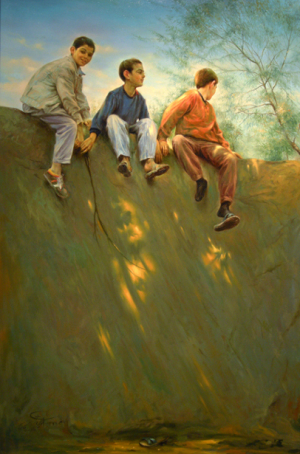(Boylove Documentary Sourcebook) - An Anecdote Regarding a Love Triangle between Two Men and a Teenage Boy in 1950s Tehran: Difference between revisions
(Created page with "thumb|center|View of Tehran, Tehran Province, Iran (1950s). From <i>Sexual Politics in Modern Iran</i> by Janet Afary (Cambridge; New York...") |
m (Dandelion moved page (BLSB) - An Anecdote Regarding a Love Triangle between Two Men and a Teenage Boy in 1950s Tehran to (Boylove Documentary Sourcebook) - An Anecdote Regarding a Love Triangle between Two Men and a Teenage Boy in 1950s Tehran) |
||
| (5 intermediate revisions by the same user not shown) | |||
| Line 5: | Line 5: | ||
<div style="margin:.5em auto; width:95%; min-height:5em; background-color:#F5FAFF; border:3px solid #c9c9ff; padding:1em;"> | <div style="margin:.5em auto; width:95%; min-height:5em; background-color:#F5FAFF; border:3px solid #c9c9ff; padding:1em;"> | ||
Homosexual practices among youth or married adult men continued to be ignored or made light of as well. According to Paul Vieille, who studied rural villages around Tehran in the 1960s, “eight out of ten boys was said to have had at least one homosexual experience of one form or another before marriage, whether with their peers or with much older men. The practice is thus transmitted from generation to generation, though it is in decline” (Vieille 1978, 165). Naim Afary recalls how factory managers in Tehran were faced with such issues in the late 1950s: | [[Homosexuality|Homosexual]] practices among youth or married adult men continued to be ignored or made light of as well. According to Paul Vieille, who studied rural villages around Tehran in the 1960s, “eight out of ten boys was said to have had at least one homosexual experience of one form or another before marriage, whether with their peers or with much older men. The practice is thus transmitted from generation to generation, though it is in decline” (Vieille 1978, 165). Naim Afary recalls how factory managers in Tehran were faced with such issues in the late 1950s: | ||
<blockquote> | <blockquote> | ||
| Line 19: | Line 19: | ||
[[File:Morteza Katouzian - Childhood Memories.png|thumb|center|<i>Childhood Memories</i> (خاطرات کودکی <i>Khaterate Koodaki</i>, 1992) by Morteza Katouzian. Oil on canvas, 92 × 60 cm.]] | [[File:Morteza Katouzian - Childhood Memories.png|thumb|center|<i>Childhood Memories</i> (خاطرات کودکی <i>Khaterate Koodaki</i>, 1992) by Morteza Katouzian. Oil on canvas, 92 × 60 cm.]] | ||
==External | ==See also== | ||
*[[Adult friend (dictionary)]] | |||
*[[Age of attraction (dictionary)]] | |||
*[[Boylove]] | |||
*[[Ephebophilia]] | |||
*[[Loved boy (dictionary)]] | |||
*[[Minor-attracted person (dictionary)]] | |||
*[[Pederasty]] | |||
*[[Pedophilia]] | |||
*[[Situational homosexuality (dictionary)]] | |||
*[[Young friend (dictionary)]] | |||
==External links== | |||
*[https://greek-love.com/near-east-north-africa/persia/introduction-to-persia GREEK LOVE IN MEDIAEVAL AND MODERN PERSIA (Greek Love Through the Ages)] | *[https://greek-love.com/near-east-north-africa/persia/introduction-to-persia GREEK LOVE IN MEDIAEVAL AND MODERN PERSIA (Greek Love Through the Ages)] | ||
[[Category:Boylove Sourcebook]] | [[Category:Boylove Documentary Sourcebook]] | ||
[[Category:Iran]] | [[Category:Iran]] | ||
[[Category:Sexuality]] | |||
[[Category:LGBT articles]] | [[Category:LGBT articles]] | ||
Latest revision as of 11:11, 3 November 2021

From Sexual Politics in Modern Iran by Janet Afary (Cambridge; New York: Cambridge University Press, 2009).
Homosexual practices among youth or married adult men continued to be ignored or made light of as well. According to Paul Vieille, who studied rural villages around Tehran in the 1960s, “eight out of ten boys was said to have had at least one homosexual experience of one form or another before marriage, whether with their peers or with much older men. The practice is thus transmitted from generation to generation, though it is in decline” (Vieille 1978, 165). Naim Afary recalls how factory managers in Tehran were faced with such issues in the late 1950s:
When we opened the Three Stars Shoe Factory on the south side of Tehran, we hired a large team of shoemakers from a nearby province for the sewing department. Each senior shoemaker worked with two or three young assistants, mostly teenage boys. Since the shoemakers were away from their homes, they asked to sleep in the factory at night, and we gave them permission to do so. One day there was a big fight in the sewing department. After some inquiries, we learned that two of the senior shoemakers had been quarreling over a boy. We called the boy to our office. He was about fourteen and was quite handsome, with blonde hair and blue eyes. He candidly revealed that the two older men were in love with him (khater kh ّah). We were disturbed by his account and wanted to fire the shoemakers. But the boy insisted that he was a willing participant in these relationships. So we let him off but told the men in the sewing department that they had to find other sleeping accommodations. The shoemakers were quite upset with the change and collectively decided to leave the factory. After this incident, we hired only women for the sewing department, and this is how women came to be employed in our factory.
(Interview, February 15, 2002)

See also
- Adult friend (dictionary)
- Age of attraction (dictionary)
- Boylove
- Ephebophilia
- Loved boy (dictionary)
- Minor-attracted person (dictionary)
- Pederasty
- Pedophilia
- Situational homosexuality (dictionary)
- Young friend (dictionary)